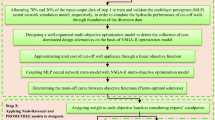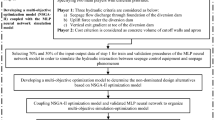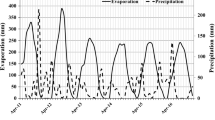Abstract
Detention rockfill dams are generally known as economic and efficient structural methods for flood mitigation and watershed management. Despite the existing studies in the context of rockfill dam design, designers still rely on time-consuming and costly experimental tests which can only lead into practical guidelines. Moreover, investigation of various rockfill dam design alternatives in terms of hydraulic performance needs an exhaustive framework to obtain the optimal design values. With respect to these, this research study aims to investigate the optimal dam thickness and mean diameter of coarse aggregates in detention rockfill dams in order to improve the hydraulic characteristics, e.g., reduction in flood peak discharge and increase in flood duration while the construction cost is minimized. Here, a methodology based on data-driven simulation model, multi-objective optimization model, multi-criterion decision making model, and social choice method is suggested to find the optimal design parameters of detention rockfill dam. This methodology adapts data to model and model to optimum design variables. Experimental results are converted to data-driven simulation model based on multilayer perceptron neural network, which can model the relationship between design variables of detention rockfill dam and parameters of flood hydrograph. The simulation model is used in a robust multi-objective optimization algorithm, non-dominated sorting genetic algorithm-ΙΙ (NSGA-ΙΙ), to establish a trade-off between the conflicting objectives. Eventually, PROMETHEE decision making model and Borda count social choice method are used to find the best agreed-upon design optimal point on the trade-off curve. Results indicate that the best non-dominated solution can be considered as 10.01 and 5 cm for the optimum thickness of detention rockfill dam and optimum mean diameter of coarse aggregates in the porous media, respectively. The similar optimum characteristics of detention rockfill dam using PROMETHEE and Borda count social choice method depict the stable performance of the proposed methodology.









Similar content being viewed by others
References
Albadvi A, Chaharsooghi SK, Esfahanipour A (2007) Decision making in stock trading: an application of PROMETHEE. Eur J Oper Res 177:673–683
Behzadian M, Kazemzadeh RB, Albadvi A, Aghdasi M (2010) PROMETHEE: a comprehensive literature review on methodologies and applications. Eur J Oper Res 200:198–215
Brans J-P, Vincke P, Mareschal B (1986) How to select and how to rank projects: the PROMETHEE method. Eur J Oper Res 24:228–238
Buffington JM, Montgomery DR (1997) A systematic analysis of eight decades of incipient motion studies, with special reference to gravel‐bedded rivers. Water Resour Res 33:1993–2029
Cavalcante C, De Almeida A (2007) A multi-criteria decision-aiding model using PROMETHEE III for preventive maintenance planning under uncertain conditions. J Qual Maint Eng 13:385–397
Chau K, Wu C (2010) A hybrid model coupled with singular spectrum analysis for daily rainfall prediction. J Hydroinf 12:458–473
Coulibaly P, Anctil F, Bobee B (2000) Daily reservoir inflow forecasting using artificial neural networks with stopped training approach. J Hydrol 230:244–257
Deb K (2001) Multi-objective optimization using evolutionary algorithms. John Wiley and Sons Ltd., England
Deb K, Pratap A, Agarwal S, Meyarivan T (2002) A fast and elitist multiobjective genetic algorithm: NSGA-II. IEEE Trans Evol Comput 6:182–197. doi: 10.1109/4235.996017
Diakoulaki D, Karangelis F (2007) Multi-criteria decision analysis and cost–benefit analysis of alternative scenarios for the power generation sector in Greece. Renew Sust Energ Rev 11:716–727
Ding Y, Wang SS (2012) Optimal control of flood diversion in watershed using nonlinear optimization. Adv Water Resour 44:30–48
Doan C, Liong S (2004) Generalization for multilayer neural network Bayesian regularization or early stopping. In: Proceedings of Asia Pacific Association of Hydrology and Water Resources 2nd Conference. pp 5–8
Fernández-Castro A, Jiménez M (2005) PROMETHEE: an extension through fuzzy mathematical programming. J Oper Res Soc 56:119–122
Figueira J, Greco S, Ehrgott M (2005) Multiple criteria decision analysis: state of the art surveys, vol 78. Springer Science & Business Media, New York
Govindan K, Rajendran S, Sarkis J, Murugesan P (2013) Multi criteria decision making approaches for green supplier evaluation and selection: a literature review. J Clean Prod 98:66–83
Gregory R, Failing L, Harstone M, Long G, McDaniels T, Ohlson D (2012) Structured decision making: a practical guide to environmental management choices. John Wiley & Sons, Hoboken
Heydari M, Talaee PH (2011) Prediction of flow through rockfill dams using a neuro-fuzzy computing technique. J Math Comput Sci 2:515–528
Heydari M, Fathi P, Marofi S, Hosseinzadeh Talaee P (2013) Comparative modeling of output discharge from rockfill dam by artificial neural network and numerical method. Watershed Manag Res 26:22–32
Hyde KM, Maier HR (2006) Distance-based and stochastic uncertainty analysis for multi-criteria decision analysis in Excel using Visual Basic for Applications. Environ Model Softw 21:1695–1710
Ikard S, Revil A, Schmutz M, Karaoulis M, Jardani A, Mooney M (2014) Characterization of focused seepage through an earthfill dam using geoelectrical methods. Groundwater 52:952–965
Jahandideh-Tehrani M, Haddad OB, Loáiciga HA (2015) Hydropower reservoir management under climate change: the karoon reservoir system. Water Resour Manag 29:749–770
Kaviani S, Hassanli A, Homayounfar M (2015) Optimal crop water allocation based on constraint-state method and nonnormal stochastic variable. Water Resour Manag 29:1003–1018
Keeney RL, Raiffa H (1976) Decisions with multiple objectives: preferences and value trade-offs. Wiley, NewYork
Khorramshokouh N (2012) Optimal thickness and transmission capacity of cohesive and non-cohesive sediment in detention rockfill dam (In Persian) Dissertation, School of Agriculture, Shiraz University
Lafleur J (1984) Filter testing of broadly graded cohesionless tills. Can Geotech J 21:634–643
Linkov I et al (2006) Multicriteria decision analysis: a comprehensive decision approach for management of contaminated sediments. Risk Anal 26:61–78
Løken E (2007) Use of multicriteria decision analysis methods for energy planning problems. Renew Sust Energ Rev 11:1584–1595
Mareschal B, Brans JP (1992) PROMETHEE V: MCDM problems with segmentation constraints. ULB—Universite Libre de Bruxelles, Brussel
Monghasemi S, Nikoo MR, Fasaee MAK, Adamowski J (2014) A novel multi criteria decision making model for optimizing time–cost-quality trade-off problems in construction projects. Expert Syst Appl 42:3089–3104
Nikoo MR, Kerachian R, Niksokhan MH, Beiglou PHB (2011) A game theoretic model for trading pollution discharge permits in river systems. Int J Environ Sci Dev 2:162–166
Nikoo MR, Varjavand I, Kerachian R, Pirooz MD, Karimi A (2014) Multi-objective optimum: a design of double-layer perforated-wall breakwaters: application of NSGA-II and bargaining models. Appl Ocean Res 47:47–52
Oñate E, Celigueta MA, Idelsohn SR, Salazar F, Suárez B (2011) Possibilities of the particle finite element method for fluid–soil–structure interaction problems. Comput Mech 48:307–318
Pandey P, Barai S (1995) Multilayer perceptron in damage detection of bridge structures. Comput Struct 54:597–608
Park CH, Joo JG, Kim JH (2012) Integrated washland optimization model for flood mitigation using multi-objective genetic algorithm. J Hydro Environ Res 6:119–126
Parnell GS, Driscoll PJ, Henderson DL (2011) Decision making in systems engineering and management, vol 81. John Wiley & Sons, Hoboken
Podvezko V, Podviezko A (2010) Dependence of multi‐criteria evaluation result on choice of preference functions and their parameters. Technol Econ Dev Econ 16:143–158
Queiruga D, Walther G, Gonzalez-Benito J, Spengler T (2008) Evaluation of sites for the location of WEEE recycling plants in Spain. Waste Manag 28:181–190
Rasekh A, Afshar A, Afshar MH (2010) Risk-cost optimization of hydraulic structures: methodology and case study. Water Resour Manag 24:2833–2851
Saaty TL (1990) How to make a decision: the analytic hierarchy process. Eur J Oper Res 48:9–26
Sheikhmohammady M, Madani K (2008) Bargaining over the Caspian Sea — the largest lake on the Earth. In: Proceeding of the 2008 World Environmental and Water Resources, vol. 10, no. 40976. Honolulu, Hawaii, p 316. doi:10.1061/40976(316)262
Singh RM (2011) Design of barrages with genetic algorithm based embedded simulation optimization approach. Water Resour Manag 25:409–429
Sowers GF (1993) Human factors in civil and geotechnical engineering failures. J Geotech Eng 119:238–256
Taormina R, Chau K (2015) Neural network river forecasting with multi-objective fully informed particle swarm optimization. J Hydroinform 17:99–113
Tetko IV, Livingstone DJ, Luik AI (1995) Neural network studies. 1. Comparison of overfitting and overtraining. J Chem Inf Comput Sci 35:826–833
Turan ME, Yurdusev MA (2014) Predicting monthly river flows by genetic fuzzy systems. Water Resour Manag 28:4685–4697
Turskis Z, Zavadskas EK (2011) Multiple criteria decision making (MCDM) methods in economics: an overview. Technol Econ Dev Econ 2:397–427
Tuzkaya G, Ozgen A, Ozgen D, Tuzkaya U (2009) Environmental performance evaluation of suppliers: a hybrid fuzzy multi-criteria decision approach. Int J Environ Sci Technol 6:477–490
Wang W-c, Xu CK-w, D-m CX-Y (2015) Improving forecasting accuracy of annual runoff time series using ARIMA based on EEMD decomposition. Water Resour Manag 29:2655–2675
Xiao-jun W et al (2014) Climate change and water resources management in Tuwei river basin of Northwest China. Mitig Adapt Strateg Glob Chang 19:107–120
Xu J, Li Z (2012) Multi-objective dynamic construction site layout planning in fuzzy random environment. Autom Constr 27:155–169
Yang J-B, Wang Y-M, Xu D-L, Chin K-S (2006) The evidential reasoning approach for MADA under both probabilistic and fuzzy uncertainties. Eur J Oper Res 171:309–343
Yang J, Li G, Wang L, Zhou J (2015) An integrated model for simulating water resources management at regional scale. Water Resour Manag 29:1607–1622
Yarar A (2014) A hybrid wavelet and neuro-fuzzy model for forecasting the monthly streamflow data. Water Resour Manag 28:553–565
Yazdi J, Neyshabouri SS (2012) A simulation-based optimization model for flood management on a watershed scale. Water Resour Manag 26:4569–4586
Yazdi J, Neyshabouri SS (2014) Adaptive surrogate modeling for optimization of flood control detention dams. Environ Model Softw 61:106–120
Yazdi J, Neyshabouri SAAS (2015) An optimization model for floodplain systems considering inflow uncertainties. Water Resour Manag 29:1295–1313
Zekri S, Triki C, Al-Maktoumi A, Bazargan-Lari MR (2015) An optimization-simulation approach for groundwater abstraction under recharge uncertainty. Water Res Manag 29:3681–3695
Zhang Q-J, Gupta KC, Devabhaktuni VK (2003) Artificial neural networks for RF and microwave design-from theory to practice. IEEE Trans Microwave Theory and Tech 51:1339–1350
Conflict of Interest
The authors of the present research study declare that they have no conflict of interest.
Author information
Authors and Affiliations
Corresponding author
Rights and permissions
About this article
Cite this article
Nikoo, M.R., Khorramshokouh, N. & Monghasemi, S. Optimal Design of Detention Rockfill Dams Using a Simulation-Based Optimization Approach with Mixed Sediment in the Flow. Water Resour Manage 29, 5469–5488 (2015). https://doi.org/10.1007/s11269-015-1129-1
Received:
Accepted:
Published:
Issue Date:
DOI: https://doi.org/10.1007/s11269-015-1129-1




